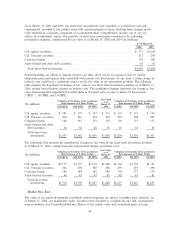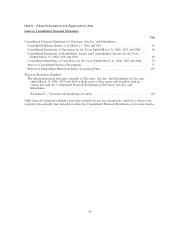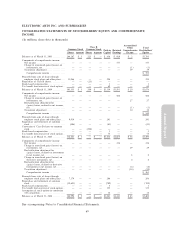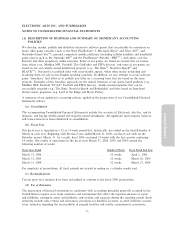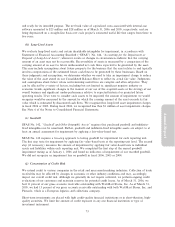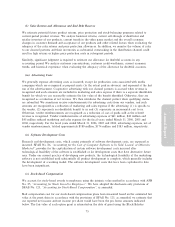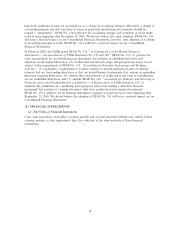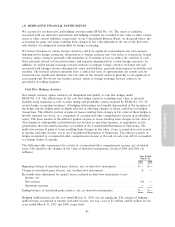Electronic Arts 2006 Annual Report Download - page 146
Download and view the complete annual report
Please find page 146 of the 2006 Electronic Arts annual report below. You can navigate through the pages in the report by either clicking on the pages listed below, or by using the keyword search tool below to find specific information within the annual report.(k) Revenue Recognition
We evaluate the recognition of revenue based on the criteria set forth in SOP 97-2, ""Software Revenue
Recognition'', as amended by SOP 98-9, ""ModiÑcation of SOP 97-2, Software Revenue Recognition, With
Respect to Certain Transactions'' and StaÅ Accounting Bulletin (""SAB'') No. 101, ""Revenue Recognition
in Financial Statements'', as revised by SAB No. 104, ""Revenue Recognition''. We evaluate revenue
recognition using the following basic criteria and recognize revenue when all four of the following criteria
are met:
‚ Evidence of an arrangement: Evidence of an agreement with the customer that reÖects the terms
and conditions to deliver products must be present in order to recognize revenue.
‚ Delivery: Delivery is considered to occur when the products are shipped and risk of loss and reward
have been transferred to the customer. For online games and services, revenue is recognized as the
service is provided.
‚ Fixed or determinable fee: If a portion of the arrangement fee is not Ñxed or determinable, we
recognize that amount as revenue when the amount becomes Ñxed or determinable.
‚ Collection is deemed probable: At the time of the transaction, we conduct a credit review of each
customer involved in a signiÑcant transaction to determine the creditworthiness of the customer.
Collection is deemed probable if we expect the customer to be able to pay amounts under the
arrangement as those amounts become due. If we determine that collection is not probable, we
recognize revenue when collection becomes probable (generally upon cash collection).
Determining whether and when some of these criteria have been satisÑed often involves assumptions and
judgments that can have a signiÑcant impact on the timing and amount of revenue we report. For
example, for multiple element arrangements, we must make assumptions and judgments in order to:
(1) determine whether and when each element has been delivered; (2) determine whether undelivered
products or services are essential to the functionality of the delivered products and services; (3) determine
whether vendor-speciÑc objective evidence of fair value (""VSOE'') exists for each undelivered element;
and (4) allocate the total price among the various elements we must deliver. Changes to any of these
assumptions or judgments, or changes to the elements in a software arrangement, could cause a material
increase or decrease in the amount of revenue that we report in a particular period.
Product Revenue: Product revenue, including sales to resellers and distributors (""channel partners''), is
recognized when the above criteria are met. We reduce product revenue for estimated future returns, price
protection, and other oÅerings, which may occur with our customers and channel partners.
Shipping and Handling: In accordance with Emerging Issues Task Force (""EITF'') Issue No. 00-10,
""Accounting for Shipping and Handling Fees and Costs'', we recognize amounts billed to customers for
shipping and handling as revenue. Additionally, shipping and handling costs incurred by us are included in
cost of goods sold.
Online Subscription Revenue: Online subscription revenue is derived principally from subscription revenue
collected from customers for online play related to our massively multiplayer online games and Pogo-
branded online games services. These customers generally pay on an annual basis or a month-to-month
basis and prepaid subscription revenue, including revenue collected from credit card sales, are recognized
ratably over the period for which the services are provided.
Software Licenses: We license software rights to manufacturers of products in related industries (for
example, makers of personal computers or computer accessories) to include certain of our products with
the manufacturer's product, or oÅer our products to consumers who have purchased the manufacturer's
product. We call these combined products ""OEM bundles''. These OEM bundles generally require the
customer to pay us an upfront nonrefundable fee, which represents the guaranteed minimum royalty
amount. Revenue is generally recognized upon delivery of the product master or the Ñrst copy. Per-copy
royalties on sales that exceed the minimum guarantee are recognized as earned.
74


